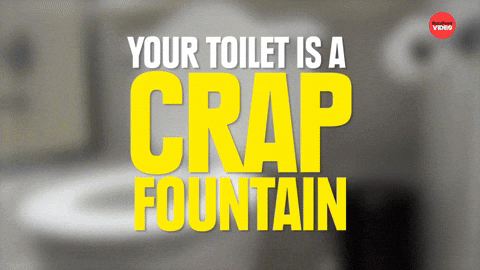Most of us use our cell phones in the bathroom. Health experts say it's a big no-no.
It's not just about the germs.

A significant majority of people admit to using their phones on the toilet.
If you're reading this article on the toilet (no judgment), chances are you're not alone. According to a NordVPN survey of 10 countries, somewhere between 2/3 and 3/4 of us have a habit of using our phones in the bathroom. Another survey found that people ages 18 to 29 use their phones on the toilet a whopping 93% of the time. That means there’s a whole lot of throne scrolling happening, and probably a lot of denial that it’s happening as well.
After all, bathrooms aren’t exactly sanitary. Most of us can deduce that having a phone anywhere near a flushing toilet is likely to contaminate it with bacteria we don’t really want to swipe onto our fingers. Ew.
Experts say the bacteria-spreading potential of using your phone in the loo is a big reason to break the habit, but it’s by no means the only one.
First, yes, bacteria gets on your phone
Is it really that much of a risk to use your phone the bathroom? Most of us do it and seem fine, don’t we?
Let's put it this way. You wouldn't willingly swipe your finger around a toilet rim, right? Scientists at the University of Arizona have found that cell phones carry 10 times more bacteria than most toilet seats, and bringing our phones into the bathroom certainly doesn't help. Our immune systems can handle a lot, but we're still exposing ourselves unnecessarily to potentially harmful bacteria such as salmonella, E. Coli and C. Difficile when we use our phones in the bathroom (or when we use the toilet and don't wash our hands afterward).
There are ways to minimize how germy your phone gets in the bathroom, such as paying close attention to what the phone is touching and what your hands are doing before you touch your phone. Closing the lid when you flush helps some, too.
Better yet, leave the phone when you gotta go, always wash your hands, and wipe down your phone with alcohol regularly. Simple, but so important.
Second, scrolling can make you spend too long on the toilet
This may not seem like a problem, but it is. Sitting on a toilet isn’t like sitting on a chair. Experts say you should spend no more than 10 minutes on the toilet to do your business, and preferably much less time than that.
“First, using your phone while doing number two can lead to prolonged sitting on the toilet, which can cause strain and pressure on your rectum and anus,” gastroenterologist Dr. Saurabh Sethi explained in a video. “This can lead to issues such as hemorrhoids, anal fissures and rectal prolapse.”
Yikes. We all know how easy it is to lose track of time when we're on our phones. When we're alone in the bathroom with nothing to distract us from our scrolling, it's even easier.

Third, the phone addiction thing
In reality, it shouldn't be too hard for us to leave our phone behind for a few minutes to use the toilet. If we always feel the need to bring our phone with us into the bathroom, what does that say about our phone habits?
I'm not saying that everyone who uses their phone on the toilet is a phone addict, but there's a good chance we're not being as mindful as we probably should be about our phone use if we automatically whip it out on the toilet. And since nearly 57% of Americans say they are addicted to their phones, maybe setting a boundary for bathroom use is a good first step toward addressing the issue.
Finally, phones do occasionally take a toilet plunge
Dropping your phone into the toilet might sound like a joke, but it happens more often than you'd think. As of 2014, around 1 in 5 Americans had dropped their phone in the toilet. Considering how much phone usage has increased since then, it's doubtful that number has gone down.
Whether it falls out of your back pocket when you pull your pants down or it just inexplicably slips from your fingers, dropping a phone in a toilet is not fun. You can imagine the various scenarios that would make it particularly bad, but even if it takes a plunge before you actually use the toilet, it's still a nightmare scenario. Nobody wants to fish a phone out of a toilet and try to figure out how to sanitize it. Not good for the phone, not good for you, not good for anyone. You can avoid the possibility completely by just not bringing the thing into the bathroom in the first place.
Habits die hard, but having solid reasons for wanting to change can be motivating. If you've been feeling iffy about bringing your phone to the toilet with you, see this as a sign to break that habit sooner than later. (Especially if you really are reading this on the throne.)
- One woman had a strange, eye-opening encounter in a Target bathroom. ›
- The most compelling argument for students keeping their phones in class is also the worst one ›
- People are jokingly ashamed of their 'normal' toilets after mom's reaction to bathroom remodel ›
- Scrolling while pooping dramatically raises your chance of getting hemorrhoids - Upworthy ›



